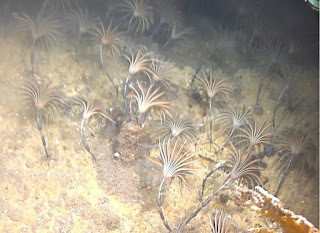I’m Tammy Noble-James, Marine Protected Areas Monitoring Officer at JNCC, and I’ve been aboard the Scotia since we began our survey of North-East Faroe Shetland Channel NCMPA and Wyville Thomson Ridge SAC on 20th October. Having completed leg one of the survey, myself and my shift-mate Jess Taylor (the ‘A team’ as we like to refer to ourselves), have added Offshore Survey Manager Neil Golding to our well-oiled JNCC machine. This is an account of our typical day…
09:30: Having
pressed snooze several times I drag myself out of bed and psyche myself up for
some exercise. Hitting the ‘gym’ (a shipping container with rowing machine and
exercise bike) several times a week is essential to feel vaguely human. It’s easy
to become sedentary on the ship, and my colleagues delight in trying to fatten
me up with tasty ‘Percy Pig’ sweets on shift, so a burst of activity is a good
way to start the day. After the bike session Neil and I suffer through some
bootcamp circuits.
 |
| Home comforts and survey essentials! |
10:30: I hit the
shower (no easy feat when the waves are high), and relax in my cabin for a
while. We are lucky on this trip; there is enough space for everyone to have
their own en-suite cabin. This makes a huge difference when offshore for any
length of time; personal space is at a premium when we spend all our work,
eating and leisure time together! My cabin is cosy and I never get tired of
watching the waves crashing against the porthole.
11:30: Lunchtime.
The job of the offshore chef is fraught with danger… get it wrong and you could
have a mutiny on your hands, or at least a seriously grumpy crew. Luckily, we
have a fantastic galley crew who work tirelessly to keep us well-fed and happy with
a menu of delightful grub.
12:00: The day
shift begins, with a turbo cup of coffee and a handover with the night crew.
They have completed 10 drop camera stations whilst we were asleep, adding
significantly to our knowledge of the stony reef habitat within the Wyville
Thomson Ridge SAC, and slowly building the first datapoint in our monitoring
time series for the site.
12:30: Our first
camera transect of the day. The three of us JNCC scientists and a Marine
Scotland Science electronic engineer are in the camera operations centre
(another shipping container), all working to collect georeferenced images of
the seabed. Our engineer deploys the drop frame camera through the murky
depths, passing the odd jellyfish, until we reach the rocky seabed at 450
metres. We take photographs and positional data as the camera glides above the
seabed, spotting sponges, redfish, sea cucumbers, sea stars, sea urchins and
squat lobsters. This rocky material, deposited thousands of years ago by
icebergs ploughing through the seabed, provides a complex habitat and attachment
surface for a wide range of deep-sea creatures.
 |
| The 'A Team' in the camera operations centre. |
15:00: Time for
more coffee. We have around 30 minutes to travel between each camera transect, during
which we refresh our caffeine levels whilst keeping on top of our data
management. When we’ve completed our data entry, Dave the deck technician drops
in to teach us some nautical knot-tying skills.
17:30: We change
out of our protective gear and head up to the mess for a delicious curry. There
are a few faces missing at the table… some newly arrived scientists are suffering
a bout of sea sickness and are tentatively nibbling on crackers in their
cabins. This debilitating condition is unfortunately all too common up here in
the Atlantic due to the stormy November weather. Just another sacrifice in the
name of science!
00:00: We made
it! After 12 hours of toil we are delighted to find we’ve completed 11
transects (one more than the night shift!). Our colleagues arrive to relieve
us, and we are free to enjoy twelve hours of unfettered freedom and sleep
before we come back and do it all over again.
 |
Surveying the depths of the Wyville-Thomson Ridge MPA which
provides a complex, rocky-reef habitat for various species.
|
For more updates from the team, make sure to follow @JNCC_UK on twitter and this blog by entering your email address on the right hand side of the screen.
Written by Tammy Noble-James.
Seabed images copyright JNCC/MSS.
Non-seabed images copyright Tammy Noble-James/JNCC.
















































